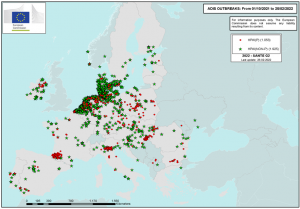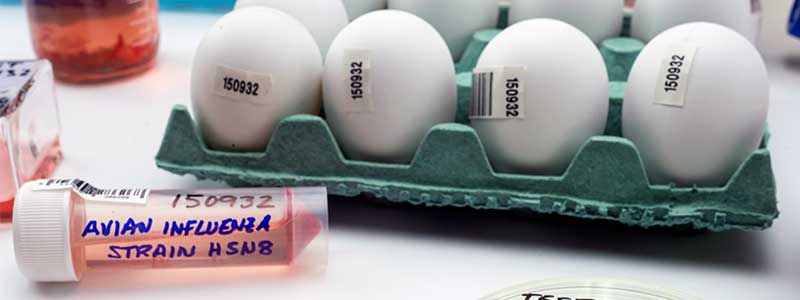Avian Influenza (AI) is a highly contagious viral disease that affects both wild and domestic birds. Commonly known as bird flu, it is present all over the world and has different strains, which are more prevalent in certain areas of the world than others.
AIl is included in the list of diseases requiring immediate notification by the World Organization for Animal Health (OIE) and the European Union.
Avian Influenza outbreaks seriously affect the poultry sector, both internationally and nationally. For its producers and ranchers, it often means slaughtering healthy birds to contain outbreaks and restricting international trade in live birds. In addition, public opinion may be affected, causing travel and tourism to affected those areas.
But these outbreaks, which unfortunately can have devastating consequences for the poultry industry, are not dangerous for humans if they have not been in contact with any infected bird or affect consumption.
Avian Influenza Situation in Europe
Europe is experiencing the worst wave of avian flu, according to the virologist and senior scientist at the CSIC Animal Health Research Center (CISA) Aitor Nogales. In the last two weeks alone, 12 European countries have reported outbreaks of bird flu, with France and Italy still the most affected by this epidemic.
As shown on this map, these are the outbreaks of Avian Influenza detected in Europe this 2021-2022 season until February 25.

IA Focus Europe until 25th February 2022 (Font: ADIS).
The most prevalent variant of the virus to date, the H5N1 serotype continues to be detected in wild birds throughout the continent. The OIE has been calling for months to have greater surveillance of avian influenza, due to the considerable increase in outbreaks that have taken place, especially in northern Europe in poultry and wild birds, according to this press release from the OIE organization.
The disease, despite being seasonal (from October to April), spreads quickly due to the migratory routes followed by wild birds in search of a warmer climate, since these and especially those found in aquatic environments constitute the natural reservoir of the virus.
What about in Spain?
Spain had been lucky so far, since the outbreaks in northern Europe had not affected. But unfortunately it was a matter of time before they would get here.
Avian flu has reached Spain, and it is already considered the most serious outbreak that has been recorded so far. The first outbreak was detected in five birds found dead in the Segre River in Lleida in the first week of this year 2022. And the first in poultry was declared a few days later. To date, outbreaks have been found in Andalusia, Castilla y León and Catalonia. This has been the schedule of his return.
To take action on the matter, as a preventive measure, Spain has already slaughtered more than 269,000 birds and experts point out that the damage could become more serious due to the drought and lack of rain. As this article states, lack of water increases the risk of transmission of this virus that jumps from migratory birds to turkey and chicken farms.
Measures to fight and stop the spread of Avian Influenza
Due to the stability of the virus in the environment and its highly contagious nature, two fundamental factors to guarantee protection against outbreaks of this disease are correct hygiene and implementing strict biosecurity measures and reinforcing those already present.
But how do you act in professional poultry farms?
Measures to prevent outbreaks include keeping poultry out of areas frequented by wild birds, keeping farms, chicken coops and equipment in good sanitary conditions and also maintaining strict control of vehicle access to farms, staff and equipment.
And once an outbreak is detected, to control and eradicate the disease, a stamping-out policy is applied, as well as the decontamination of the warehouse and a waiting period of at least 21 days before restocking, among other requirements.
You can consult all the measures that the OIE recommends and those that are mandatory if an outbreak is detected here. In addition, from the MAPA (Spanish Ministry of Agriculture, Fisheries and Food) it is also recalled that if there is any suspicion of disease in your farms you must immediately notify the official veterinary services, apart from the fact that it has been authorized that in the autonomous community the competent authority can establish more restrictive measures if deemed necessary.
And what happens in self-consumption poultry farms?
In poultry farms intended exclusively for family consumption, the biosecurity and hygiene measures that must be implemented to reduce the risk of introduction and spread of the disease are to prevent the access of wild birds to food and drink containers from where the self-consumption birds feed and not supply water from rivers, swamps or external sources as well as a periodic disinfection of the facilities, among others that you can consult here.
Correct maintenance of your farms is essential to prevent the spread of diseases in your farms. At TIGSA we can check that all access points such as windows or bird cages are well insulated and prepare a maintenance plan for each type of poultry farm. In this way we will obtain more sustainable and efficient farms.
Contact us and we will analyze the situation of your farms to improve them

